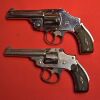I just finished watching Mike Beliveau's video. While I respect Mike a great deal, and have chatted with him on some internet forums, I would like to correct a couple of things he said.
Early in his video, MIke talked about the Smith and Wesson Tip Ups. There were three sizes of Tip Ups, Mike only mentioned the #1 and the #1 1/2. He did not mention the #2. In this photo, top down, we have a #2, #1 1/2, and #1.
The #1 came first, a tiny 7 shot revolver firing what we would call today the 22 Short. The #1 was introduced in 1857, and various versions of it were produced up until 1881.
The next Tip Up that S&W produced was the #2, a much larger, six shot revolver chambered for the 32 Rimfire cartridge. This model was made from 1861 until 1874. It was popular with Union officers during the Civil War. Although not as powerful as the big 44 caliber Cap & Ball revolvers of the day, it could be reloaded much quicker. I have read that James Butler "Wild Bill" Hickock had one of these in his pocket when he was gunned down in Deadwood in 1876.
As towns in the Old West began implementing laws against open carry, S&W produced the # 1 1/2, a five shot Tip Up small enough to be easily concealed in a pocket. Introduced in 1865, this revolver also fired the 32 Rimfire cartridge. That is why this model is called the #1 1/2, The names #1 and # 2 were already taken and this model was intermediate in size between the other two.

This photo shows how the Tip Ups, a #2 in this case, were loaded and unloaded. A latch at the bottom of the frame was depressed, allowing the barrel to swing up. The cylinder was then removed from the frame and empty cases were shoved out with the rod under the barrel. New cartridges were loaded into the cylinder, then the cylinder was popped back into the frame and the barrel was lowered, ready to fire.
The hammers of the Tip Ups only had two positions. All the way down or full cock. There was no half cock or safety cock position. When the hammer was down, the firing pin rested directly on the rim of a cartridge under the hammer. I have fired one of these a few times, and I only load five rounds and swing down the barrel with an empty under the chamber. I'll bet Wild Bill loaded all six.

Mike mentioned the Smith and Wesson 38 caliber Baby Russian model and quoted an astronomical number of them being produced. He was generalizing. The Baby Russian was also known as the 38 Single Action 1st Model. This model was only produced from 1876 to 1877, and there were 25,548 produced. This model was followed by the 38 Single Action 2nd Model, and then the 38 Single Action 3rd Model. Only the 1st model is known as the Baby Russian by collectors.

Let's look inside a Baby Russian. Three photos showing the hammer all the way down, the half cock loading position, and full cock. Again with that tiny sear, I would be reluctant let the hammer down to the half cock position with a live round under it. But seeing as this was a five shot, not six shot revolver, I might load all five if I was carrying one on a dark night in a bad section of town.



Mike mentions the S&W Safety Hammerless revolvers, sometimes known as Lemon Squeezers because of the grip safety. I have a few of them, both 38 and 32. This is one model I would feel comfortable loading with all five rounds, because the grip safety makes them safe to carry with a live round under the hammer.

Somewhere in his video Mike mentioned that the 38 S&W cartridge was responsible for a great many shootings in the cities in the 19th Century. I took this photo a number of years ago in a museum next to one of the lakes in Central Park in New York City. This S&W 38 Double Action was dredged up out of one of the lakes. Clearly it was in the lake a long time, seeing how much of it has rusted away. I suspect somebody must have pitched it into the lake after committing a crime with it. The last time I visited that museum the pistol was no longer on display.



























